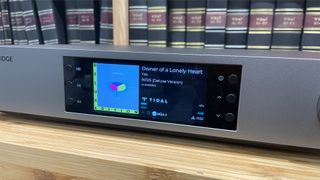Cambridge Audio CXN100
Cambridge Audio CXN100 review
Can this updated music streamer reach the heights of its illustrious predecessor? Tested at £899 / $1049 / AU$1899
By What Hi-Fi?

(Image: © What Hi-Fi?)
What Hi-Fi? Verdict
Improvements in clarity, precision and spaciousness mean the amply-featured and user-friendly CXN100 streamer remains the one to beat at this price
Pros
- Clean, precise and articulate sound
- Expansive, open soundstage
- Extensive features and specs
- Lovely to use
Cons
- Loses a touch of its predecessor’s sonic solidity and warmth
Following a much-loved, illustrious product is no easy task in the world of hi-fi. At best, it can improve upon every element to deliver an even more engaging performance without sacrificing its essence. At worst, it can completely detract from what made it so special in the first place.
Naturally, Cambridge Audio aims (and hopes) for its new CXN100 music streamer to be in the first camp. It has the ambitious task of following in the footsteps of the excellent CXN (V2), which has won a What Hi-Fi? Award six years in a row and has the distinction of being the first network audio streamer to enter our Hall of Fame.
But with the brand’s recent track record of five-star products, surely it should be plain sailing? The CXN100 doesn't stray too far from its popular formula on the surface, but it has been completely redesigned internally – bringing with it more advanced specs and features and, for the most part, an improved audio performance.
Price

(Image credit: What Hi-Fi?)
The Cambridge Audio CXN100 costs £899 / $1049 / AU$1899 and is available to buy now globally.
In the UK, the CXN (V2) launched at £700 back in 2018, but the retail price has since risen to £799 in recent years. However, last year's winter sales saw the price slashed to a very tempting £599. The new CXN100 fully replaces the CXN (V2) and the latter will now only be sold until stocks last – if you can find it, there may be a good deal to be had.
We're not surprised to see a price hike in the new model, but we are pleased that Cambridge Audio has been able to keep it under the £1000 / $1000 mark.
Around this price level are rival streamers such as the Eversolo DMP-A6 at £759 / $859 / AU$1399, while more affordable options from Bluesound (Node 2021), Audiolab (7000N Play) and Cambridge Audio itself – the MXN10 – are worthy alternatives.
Build & design

(Image credit: What Hi-Fi?)
At first glance, the CXN100 looks identical to the CXN (V2). It sports the same sleek, metal chassis in Cambridge's trademark lunar grey finish, and the dimensions are identical. The design is elegant and the build quality is on par with the rest of the CX range.
Look closer, and there are small cosmetic refinements made to the new model for a cleaner, more minimalist look. The front panel’s display screen is higher resolution and a smidge larger at 4.8in (up from the predecessor’s 4.3in). It remains easy to read at a glance, with crisp text and colourful, bright album artwork. There are fewer buttons surrounding the screen, and the menu system is updated to match the more user-friendly one on Cambridge’s Evo 75 and Evo 150 systems. The USB type A port has been removed from the front, too.
The CXN100 works well and is responsive throughout, whether we’re using the on-unit controls or the comprehensive StreamMagic control app. There’s no remote control included in the box this time, but you can buy one separately or use the same remote you get with the CX amps or CXC transport. We imagine most people will use the smartphone/tablet app regularly, and you can employ firmware updates and activate the preamp function through the app, too.
The only discernible difference we found when comparing the CXN100 against the older CXN (V2) model is with the control/volume dial. It has a looser feel in the new model, whereas the previous model had a more damped, premium feel to it when turned. It’s a small niggle, admittedly.

It’s inside where all the changes have been made. The CXN100 has been redesigned from the ground up, sporting the latest streaming module and a new DAC. We’ve already encountered the fourth generation of Cambridge Audio’s proprietary StreamMagic streaming platform in the Evo and MXN10, so it was high time that the CXN streamer was brought up to date. Coupled with this is a new DAC – a 32-bit ESS ES9028Q2M chip – which was chosen by the brand’s engineers, after hours of listening and comparing, for its audio performance over the CXN (V2)’s dual Wolfson 24-bit chips.
Cambridge says this ESS DAC chip's own timing filter is good enough that there's no need for any post-DAC filters or EQ, and is designed to retain the original signal – and therefore the original sound of a recording – as much as possible. Uprated capacitors and op-amps in the post-DAC analogue stage are used to reduce distortion and deliver a better signal-to-noise ratio.
CAMBRIDGE AUDIO CXN100 TECH SPECS

Max resolution 32-bit/768kHz, DSD512, MQA
Streaming features UPnP, AirPlay 2, Chromecast, internet radio, Spotify Connect, Tidal Connect, Roon Ready
Network Ethernet, wi-fi
Inputs USB type A, USB type B, optical, coaxial
Outputs Optical, coaxial, balanced XLR, RCA
Remote? No
Headphone output? No
Finishes x 1 (lunar grey)
Dimensions (hwd) 8.5 x 43 x 30.5cm
Weight 3.55kg
Features & connectivity

(Image credit: What Hi-Fi?)
Thanks to this new DAC, the CXN100 is now able to handle hi-res files up to 32-bit/768kHz PCM, DSD512 and MQA files natively. Whatever music file you have, no matter where it’s stored, what quality it’s in or how you want to play it, the CXN100 will oblige.
The features list is as comprehensive as you’d expect in a modern network streamer: AirPlay 2, Chromecast, Bluetooth (which is now integrated in this model), Tidal Connect, Spotify Connect, as well support for Deezer, Qobuz and internet radio. It supports UPnP streaming so you can play any local files stored on a NAS device or connected hard drive, and it’s Roon Ready. Whether using wi-fi or wired ethernet, we didn’t experience any dropout issues during testing.
Wired connectivity remains just as comprehensive. You’ll find single digital optical and coaxial inputs, USB type A and USB type B ports, and single optical and coaxial outputs. On the analogue side, there are balanced XLR and RCA line-level outputs. We like that Cambridge has continued its helpful tradition of printing each connection’s labels upside down, so it’s easy to read when leaning over the unit.
Switching between multiple sources and playing various file types didn’t once trip up the CXN100, which is admirable for such a product that has to juggle so many elements. The control app recognises the CXN100 instantly when connected, and we found controlling music playback and managing all sources to be easy and fuss-free during daily use.
Sound

(Image credit: What Hi-Fi?)
We plug the CXN100 into both of our hi-fi reference systems of Burmester 088/911 MkIII / ATC SCM50 and PMC Cor / Epos ES14N, and spend considerable time listening to it against the outgoing CXN (V2) and in its own right.
What strikes us immediately is just how clear and articulate the new model is. There’s a sparkling clarity to the sound, revealing ample detail from every song we stream through the CXN100. This is complemented by leading edges of notes that stop and start with startling precision – Major Lazer’s Pon De Floor is a perfect example, with every beat crystal clear, controlled and neatly etched, and this whole presentation leads to a faster, snappier and more propulsive performance.
Play Living Colour’s Cult Of Personality and the snippets of various political addresses peppered throughout the song have a distinct tone compared with the rest of the powerful song. The CXN100 comfortably delivers grunt behind that superb guitar riff, too. It’s an expansive, spacious sound – one that’s far wider and open than the previous CXN (V2).
We don’t get to say this very often, but the CXN100 sounds great with heavy metal tracks, with a top end that strikes the right balance between smoothness and bite, and low end notes that are tautly pulled. Its refinement means that we can punch up the volume to party levels without things getting messy or too fatiguing. The CXN100 is also able to slow down to let us luxuriate in the hazy, sun-kissed dreamy tune of Waxahatchee’s Right Back To It.

(Image credit: What Hi-Fi?)
We find the streamer’s character remains consistent regardless of the input or streaming method used. Feed it higher-resolution FLAC or WAV files and the CXN100 springs to life and shows off greater complexity and depth than its predecessor; songs streamed over Bluetooth or AirPlay sound a touch simplified, but the CXN100 still plays every track – no matter its file quality – with gusto.
The longer we listen, the more we find that the CXN100 is missing an ounce of solidity and warmth – qualities we found so endearing in the CXN (V2). The CXN (V2)’s richer, warmer character is more relaxed, and makes for a slightly more natural way with voices in particular. The CXN100 is without question the step-up performer when it comes to clarity, precision and spaciousness, and the leaner presentation allows for a faster, cleaner, attacking sound. But it’s a shift in sonic balance from a sound we’ve known for years, so we called in a second sample of the CXN100 to double-check and can confirm that this character is consistent in the new model.
Verdict

(Image credit: What Hi-Fi?)
The CXN100 remains as user-friendly and seamless to use as ever, and the leaps in clarity, openness and precision are impressive to hear. If you’re after a music streamer that can do it all and reveal more about your music collection than you’ve heard before, this Cambridge streamer remains the one to beat at this level.
SCORES
- Sound 5
- Build 5
- Features 5

